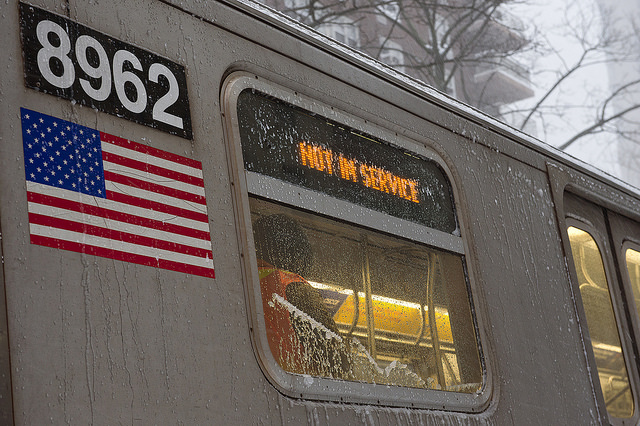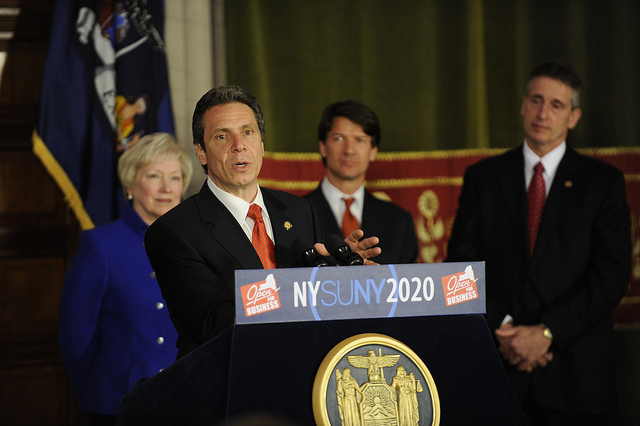What To Do When The L Train Closes

Out of service (photo: MTA/Patrick Cashin)
The denizens of Williamsburg and Bushwick have responded to news of potential multiyear L train closures with a mix of shock, despair, and irritation. People are talking through the alternatives: taking the G, J, and M trains; boarding the East River Ferry; or even (gasp!) riding the bus. Quite likely Williamsburgers will also summon a swarm of UberPools and Lyft Lines unlike any seen in our time.
Hysterics aside, it’s unlikely that the MTA would do a full, year-long double-tube shutdown. The most plausible plan is a long series of “nights and weekends” shutdowns for tube repairs, with the possibility of a brief total closure of both tubes to finish them “Fastrak”-style while rehabs of the 1st Avenue and Bedford stations and additional electrical substations are built. The latter service upgrades, which would permanently boost the line’s peak-hour capacity by 10 percent (a big deal for a subway line often at “crush” capacity during rush hour), depend on the timely success of Senator Chuck Schumer’s request to expedite federal funding. Nothing is certain until the upgrade funding comes through, but some Sandy-related stretch of nights-and-weekends closures is sure to come, as the MTA’s initial bid requests describe a contract lasting about 40 months.
If the MTA does indeed briefly close both tunnels—or even just one at a time—what should be done to limit the carnage? First, carpool restrictions (HOV-2, or even HOV-3) on the Williamsburg Bridge during train closures—just like during transit strikes and natural disasters. Previous nights-and-weekends closures of the L have brought “Carmageddon” to the bridge, especially during UberPool and Lyft Line promotions. Ensuring that solo drivers don’t hog every lane is a surefire way to keep everyone moving.
I personally remember the bridge congestion during the UberPool $2.75-a-ride L train closure special, as it was both the first time I shared an UberPool and the first time I rode with a carsick middle-aged woman being ill out the back window into the East River.
So to minimize the stop-and-go, nausea-inducing congestion—and maximize the potential efficiency of ridesharing services—the city should cooperate with the MTA in implementing HOV restrictions on the bridge, and even dedicating a lane to shuttle buses and the B39. It’s not at all radical to take away a car lane for more efficient transportation modes: The Williamsburg Bridge was built for streetcars.
This potential L train crisis is a reminder that better transit redundancy plans are needed for high-volume chokepoints, even if they inconvenience a comparatively small number of drivers. A truly radical long-term proposal would involve permanently replacing some car lanes with transit-only lanes and re-opening the abandoned streetcar terminal under Essex Street on the Manhattan side of the bridge. Current proposals include replacing the terminal with an odd subterranean mushroom park.
But if the real estate industry ever gets serious about funding a public-private waterfront streetcar through Williamsburg, perhaps restoring the rail lanes to the old streetcar terminal could be added to the plan. No matter what the MTA decides, the coming L train closures are an opportunity to start getting creative with our transportation systems and our waterfront. Let’s hope at least some of these mitigation proposals get a serious hearing.
***
Alex Armlovich is a policy analyst at the Manhattan Institute. On Twitter @aarmlovi.
***
Have an op-ed idea or submission for Gotham Gazette? Email This email address is being protected from spambots. You need JavaScript enabled to view it.
As Federal Aid System Advances, Our Outdated Way Leaves New York Students Behind

Gov. Cuomo and SUNY 2020 (photo via The Governor's Office)
If New York wants to put students first, it must align financial aid statute
with the updated federal FAFSA.
FAFSA (Free Application for Federal Student Aid) is the form that has been used to determine how much federal financial aid, and in some cases institutional financial aid, students receive since the early 1990s. Over the course of the last several years, the Obama Administration has worked to streamline the process, including an Executive Order announcing that beginning with the 2017-2018 academic year, FAFSA completion will utilize tax data from the year prior to the previous tax year (also known as "prior-prior") to make it easier for students and families to complete this critical form.
This is a change that advocates like NYSFAAA and Young Invincibles have been pushing for years. And, New York must act this year to bring its processes to meet the same type of standards.
So why are these changes such a big deal for students? In short, it can be incredibly difficult for students to find and use their previous year's tax information. Let's not forget that in many cases we are asking high school students to understand, process and use complicated tax information. Many students who complete the FAFSA before April of any given year end up using estimated tax information if they or their parents have not yet completed the most recent tax return.
This causes complications for both students and colleges, as families end up having the difficult task of trying to estimate their income information, and in turn schools end up having to award aid based on these estimates. Corrections to the data after taxes are actually filed can throw students who are already enrolled in a college for a serious and detrimental loop. What's worse, the aid pool can dry up while these institutions wait for accurate information. Either way, in some cases the aid they thought they could have suddenly seems to just disappear and with it, potentially the dream of going to school.
Most states are equipped to accommodate this transition to prior-prior year income data without a change in state law. New York, however, is one of the states that cannot seamlessly make this transition, and right now because of this students are going to bear the burden.
Completion of the New York State financial aid application for TAP (Tuition Assistance Program) requires by law that only prior year income be used in the determination of awards. This creates a disconnect between the federal aid application and the state aid application, making the system incredibly confusing and difficult for students to navigate. Fixing this disconnect and eliminating this burdensome requirement, as the federal system has done, could be the difference between a student going to college and a student being left behind by our state.
To remedy this problem and ensure that the application itself doesn't become an unnecessary barrier to aid, a statutory change in New York is needed that would require TAP to use prior-prior year income data. While there are a number of necessary reforms needed to bring the Tuition Assistance Program into the 21st century, this statutory change to align with federal regulation is common sense and an easy lift, and it must be done before the end of the legislative session in Albany.
The rising cost of getting a college degree is already a barrier to many New Yorkers, the financial aid application process should be the least of their concerns.
***
by Sue Mead, Government Relations Chair for the New York State Financial Aid Administrators Association, and Kevin Stump, Northeast Director for Young Invincibles NY.
***
Have an op-ed idea or submission for Gotham Gazette? Email This email address is being protected from spambots. You need JavaScript enabled to view it.
Common Core Mistakes Worth Not Repeating

State Education Commissioner Elia visits a school (photo: @NYSEDNews)
Political expediency is terrible policy.
This idiom is crystal clear when it comes to the criticisms of the Common Core. To hear the cynics tell it, repealing the Common Core learning standards is as easy as 1, 2, 3; repeal them, increase scores, then everything is fine.
But it is not nearly that simple.
As policymakers consider the next steps in strengthening New York's education system, and legislators enter yet another session fraught with politically motivated self-interests in Albany, it is important they learn from the mistakes other states have made.
There are real costs associated with replacing Common Core, and perhaps even more importantly, the process of doing so results in chaos in our classrooms. The warnings are clearly spelled out in a new report from High Achievement New York – and our state's leaders would be foolish to ignore them.
Despite the heated debate and rhetoric about Common Core around the country, including among presidential candidates, only two states, Indiana and Oklahoma, have actually repealed the standards and tried to replace them with something new and different.
What perhaps sounded like a quick fix designed to appease political agitators turned into a costly waste of taxpayer dollars and left confused teachers in both states.
Indiana spent $170 million to repeal the Common Core. The change came at a time when educators in that state were indicating they were just getting comfortable with the standards. Learning and preparing to teach new education standards is a difficult process; and one that teachers are usually given a year or more to adapt to. In Indiana, they only had three months. The haphazard change resulted in frustrated and flustered educators which hurt the education of every child in that state.
It was complaints about overtesting that, in part, drove Indiana to make this rushed change. The state's plan truly backfired and parents and students bore the brunt of the change. Indiana rolled out a new exam in 2015, which included 12 hours of testing time, double that of the previous year. That number is now at nine hours of testing time, again more than when the Common Core standards were in place.
In Oklahoma, the cost of repealing Common Core totaled $125 million. The state reverted back to old standards – which had failed to adequately prepare students for college and careers. In fact, 40 percent of Oklahoma's high school graduates under those standards needed remedial courses as college freshmen.
Elsewhere around the country, there are countless states that reviewed the Common Core looking to solve their political problems yet ended up leaving the standards themselves largely intact.
South Carolina's new standards are 90 percent aligned to Common Core and it is much the same for West Virginia's new standards.
In New Jersey, a review resulted in the recommendation to keep 85 percent of standards and to continue administering the PARCC exam developed by a consortium of states and aligned with the Common Core.
The story is much the same in Florida, Arizona, and Iowa where the standards were simply rebranded with new names.
Experience elsewhere clearly indicates that forcing the repeal of Common Core is the wrong move for our children and would be a colossal waste of time and money.
Instead of putting politics first, our policymakers, from the Governor to the Regents and Education Commissioner, should work towards customized standards that meet the unique needs of our students, while remaining closely aligned to the Common Core.
So what should we take away from all these efforts to help us make the right decisions here in New York right now?
First, and most importantly, trying to repeal or substantially replace the Common Core standards would be a waste. It would be a waste of time, a waste of money, and worse it would plunge classrooms into confusion, setting yet another generation of children back.
Second, new "New York" standards must be as or more rigorous than the Common Core. We cannot forget why these rigorous standards were implemented in the first place – to actually prepare children for college and 21st century careers. Standards that promote critical thinking and reasoning are essential so that our children have the tools to succeed in an increasingly global economy.
Rigorous standards based on the Common Core and assessments aligned with those standards give us the baseline to ensure that all children are advancing together. We cannot go backwards on this.
Third, when politicians become too involved in the mechanics of what happens in the classroom, nothing good happens. That is why any review process should be driven by the professionals at the State Education Department – the people who know education policies the best.
Fourth, and similarly, classroom teachers must be the driving voices in any revisions. Teachers are on the front lines and understanding what is working in our classrooms and what is not.
And finally, a new name actually matters. Renaming the standards, yet keeping them based on the Common Core, removes from the debate what has been a name easily demonized for political purposes. Instead, New Yorkers would be able to turn their attention to the standards themselves. When that happens, as shown in a recent Center for American Progress poll and in countless states, rigorous standards are overwhelmingly popular.
Students, teachers, and parents in other states learned the pitfalls of replacing Common Core the hard way. In New York we don't have to.
***
Stephen Sigmund is the Executive Director of High Achievement New York and Denise Toscano is an Elementary Principal in Suffolk County. She is a member of High Achievement New York and an America Achieves' New York Educator Voice Fellow.
***
Have an op-ed idea or submission for Gotham Gazette? Email This email address is being protected from spambots. You need JavaScript enabled to view it.




